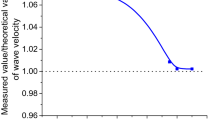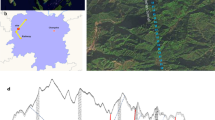Abstract
Thick earth-rock filled embankment of large earthwork volume often occurs during the construction of expressways in mountainous and hilly areas. The compaction quality of earth-rock filled subgrade will directly affect the settlement deformation and stability of the embankment after filled. Therefore, effective evaluation on the compaction quality of the earth-rock filled subgrade is an unsolved critical technical issue to control the construction quality of highway engineering. Based on the wave propagation and electrical resistivity characteristics of the earth and rock fillings, a theoretical model of the compaction quality detection by wave-electric field coupling imaging diagnostic method was established. Then, two filled subgrade models containing cavities and heterogeneous bodies respectively were make separately, and by the wave velocity testing and electrical resistivity testing, the wave-electric field coupling imaging diagnostic method was applied to these two model. The result shows that it is feasible to use the wave testing technique and the electrical resistivity testing technique for a diagnostic test of the subgrade compaction quality. Based on the abnormal areas reflected by the wave velocity imaging and electrical resistivity imaging results, we are able to analyze the scope and site of distress but not able to quantitatively evaluate the subgrade compaction quality. We can accurately qualitatively analyze the subgrade compaction quality based on the wave-electric field coupling calculation model of fill subgrade quality proposed by this paper.
Similar content being viewed by others
References
Chai HJ, Chen QY, Kong XC, et al. (2004) Overview of soilstone high embankment construction study. Rock and Soil Mechanics, 25(06): 1005–1010. DOI: 10.16285/j.rsm.2004.06.038 (In Chinese)
ASTM (2015) Standard test methods for in-place density and water content of soil and soil-aggregate by nuclear methods. D6938, West Conshohocken, PA. DOI:10.1520/D6938-15
ASTM (2008) Standard test methods for density and unit weight of soil and rock in place by the sand replacement method in a test pit.D4914, West Conshohocken, PA. DOI: 10.1520/D4914-08
Cao WG, Hu TH, Luo H, et al. (2008) Discussion on a new technique for detecting compactness of soil-rock mixture roadbed. Journal of Hunan University: Natural Science 35(2): 22–26. (In Chinese)
Livneh M, Livneh NA (2013) Use of the one-point proctor modified compaction method in family compaction curves possessing a limited trend characteristic. airfield and highway pavement 2013: Sustainable and efficient pavements ASCE 1304-1315. DOI:10.1061/9780784413005.110
Gucunski N, Maher A (2002) Evaluation of seismic pavement analyzer for pavement condition monitoring. Final Rep., FHWA-NJ-2002-012, New Jersey Dept. of Transportation Division of Research and Technology, U.S. Department of Transportation, Washington, DC.
Ilori A, Okwueze E, Obianwu V (2013) Evaluating Compaction Quality Using Elastic Seismic P Wave. Journal of Materials in Civil Engineering© ASCE 25(6): 693–700. DOI: 10.1061/(ASCE)MT.1943-5533.0000559
Gu HM, Song XH (2001) Evaluation of the effect of compacting highway surface using shear velocity inversed by instantaneous Rayleigh wave. Geological Science and Technology Information 2(20): 100–102. (In Chinese)
Minchin RE, Thomas HR (2003) Validation of vibration-based onboard asphalt density measuring system. Journal of Construction Engineering and Management 129(1): 1–7. DOI: 10.1061/(ASCE)0733-9364(2003)129:1(1)
Nazarian S, Baker M, Crain K (1993) Development and testing of a seismic pavements analyzer. Document SHRP-H-275, Strategic Highway Research Program, National Research Council, Washington DC.
Aristodemou E, Thomas-Betts A. (2000) DC Resistivity and induced polarization investigations at a waste disposal site and its environments. Journal of Applied Geophysics 44: 275–302. DOI: 10.1016/S0926-9851(99)00022-1
Fukue M, Minato M, Matsumoto H, et al. (2001) Use of a resistivity cone for detecting contaminated soil layers. Engineering Geology 60(1): 361–369. DOI: 10.1016/S0013-7952(00)00116-2
Kumari S, Israil M, Mittal S, et al. (2009) Soil characterization using electrical resistivity tomography and geotechnical investigations. Journal of Applied Geophysics 67(1): 74–79. DOI: 10.1016/j.jappgeo.2008.09.012
Zhao MJ, He Y, Rong Y, et al. (2011) Experiment on Electrical Resistivity Imaging Diagnosis of Fill Subgrade Compaction Quality. China Journal of Highway and Transport 24(3): 16–21. (In Chinese)
Zhao MJ (2007) Theoretical model for calculating compactness of soil-stone mixture foundation according to wave propagation velocity. Journal of Hydraulic Engineering 38(5): 618–623. (In Chinese)
Archie GE (1942) The electrical resistivity log as an aid in determining some reservoir characteristics. Transactions of American Institute of Mining Engineers 146: 54–61. DOI: 10.2118/942054-G
Keller G, Frischknecht F (1966) Electrical methods in geophysical prospecting. New York: Pergamom Press.
Zhao MJ, Li G, Huang WD, et al. (2010) Experiment on Electrical Resistivity Properties of Polyphase Soil- stone Mediums. Journal of Chongqing Jiaotong University (Natural Science) 29(6): 928–933. (In Chinese)
Waxman M, Smith L (1968) Electrical Conductivities in Oil-Bearing Shaly Sands. Society of Petroleum Engineers Journal 8(2): 107–122. DOI: 10.2118/1863-A
Wang K (2013) Theoretical and Applied Research on Electrical Resistivity of Multiphase Earth-rock Composite Medium, Ph.D thesis of Chongqing Jiaotong University, Chong Qing. (In Chinese with English abstract)
Acknowledgements
The research in this manuscript is funded by National Natural Science Foundation of China (Grant No. 51279219 and Grant No. 51609027), and Chongqing Research Program of Basic Research and Frontier Technology (Grant No. cstc2016jcyjA0016). The tests are supported by the Key Laboratory of Water Conservancy and Water Transportation of the Ministry of Education, Chongqing Jiaotong University. We appreciate any institutions and individuals that have provided support for this paper.
Author information
Authors and Affiliations
Corresponding author
Additional information
http://orcid.org/0000-0002-9654-295X
http://orcid.org/0000-0001-9701-3868
http://orcid.org/0000-0001-5823-9792
Rights and permissions
About this article
Cite this article
Wang, K., Zhao, Mj. & Sun, X. Wave-electric field coupling imaging diagnostic method for filled subgrade. J. Mt. Sci. 14, 382–389 (2017). https://doi.org/10.1007/s11629-016-4023-2
Received:
Revised:
Accepted:
Published:
Issue Date:
DOI: https://doi.org/10.1007/s11629-016-4023-2




